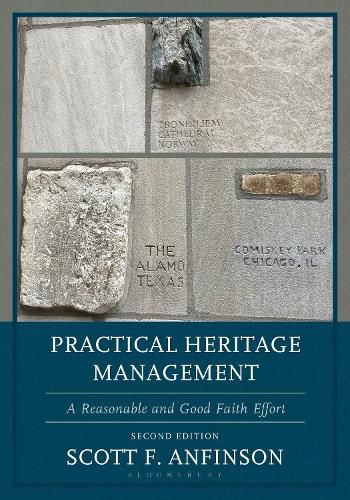Readings Newsletter
Become a Readings Member to make your shopping experience even easier.
Sign in or sign up for free!
You’re not far away from qualifying for FREE standard shipping within Australia
You’ve qualified for FREE standard shipping within Australia
The cart is loading…






This comprehensive updated edition of Practical Heritage Management addresses updates in laws and new practices in heritage management, using perspectives from archaeology, history, and architecture.
Cultural heritage management (CHM) is the identification, protection, and interpretation of archaeological sites, historic structures, cultural artifacts, and other elements of cultural heritage both tangible and intangible. In this thoroughly updated and expanded second edition, Scott Anfinson presents a comprehensive overview of American heritage management, as well as a new chapter on international heritage management. This second edition also includes discussion of new guidelines for traditional cultural properties (TCPs) and new regulations implementing the Native American Graves Protection and Repatriation Act (NAGPRA). It has an expanded discussion of Indigenous aspects of CHM including US Pacific Island and Caribbean territories. It also expands the discussion of intangible cultural resources. While emphasizing that the American CHM system in law and practice is currently focused almost exclusively on tangible aspects, intangible aspects are critically important to many communities and help explain the nature of tangible manifestations and how they are deemed significant.
The main purposes of this second edition remain the same as the first edition: to help teach the basics of CHM to the next generation of professionals and to provide current professionals with a detailed overview of the American system. Anfinson's perspective is based on extensive and continuous research, as well as 40 years of practice as a survey archaeologist, a State Historic Preservation Office (SHPO) archaeologist, a state archaeologist, and a university instructor teaching CHM. Unlike other textbooks, Anfinson's book covers all three major CHM professions: archaeology, history, and architecture, as well as presenting a full chapter on the history of American CHM.
The book's 15 chapters are made to fit a 15-week teaching semester typical of many American universities. The introductory two chapters include definitions and an explanation of what the author thinks CHM is meant to be and do, as well as the historical background to provide essential context. The next nine chapters present the legal and procedural framework of the American federal CHM system, followed by three chapters concerned with the principal professional players in American CHM. Chapter 13 discusses Indigenous aspects. Chapter 14 is the new chapter on international CHM. The final chapter summarizes a practical perspective and critically evaluates some of the important aspects of and problems with the current American CHM system, offering suggestions for improvement. Finally, there is a discussion of the implications of the Trump effect.
$9.00 standard shipping within Australia
FREE standard shipping within Australia for orders over $100.00
Express & International shipping calculated at checkout
This comprehensive updated edition of Practical Heritage Management addresses updates in laws and new practices in heritage management, using perspectives from archaeology, history, and architecture.
Cultural heritage management (CHM) is the identification, protection, and interpretation of archaeological sites, historic structures, cultural artifacts, and other elements of cultural heritage both tangible and intangible. In this thoroughly updated and expanded second edition, Scott Anfinson presents a comprehensive overview of American heritage management, as well as a new chapter on international heritage management. This second edition also includes discussion of new guidelines for traditional cultural properties (TCPs) and new regulations implementing the Native American Graves Protection and Repatriation Act (NAGPRA). It has an expanded discussion of Indigenous aspects of CHM including US Pacific Island and Caribbean territories. It also expands the discussion of intangible cultural resources. While emphasizing that the American CHM system in law and practice is currently focused almost exclusively on tangible aspects, intangible aspects are critically important to many communities and help explain the nature of tangible manifestations and how they are deemed significant.
The main purposes of this second edition remain the same as the first edition: to help teach the basics of CHM to the next generation of professionals and to provide current professionals with a detailed overview of the American system. Anfinson's perspective is based on extensive and continuous research, as well as 40 years of practice as a survey archaeologist, a State Historic Preservation Office (SHPO) archaeologist, a state archaeologist, and a university instructor teaching CHM. Unlike other textbooks, Anfinson's book covers all three major CHM professions: archaeology, history, and architecture, as well as presenting a full chapter on the history of American CHM.
The book's 15 chapters are made to fit a 15-week teaching semester typical of many American universities. The introductory two chapters include definitions and an explanation of what the author thinks CHM is meant to be and do, as well as the historical background to provide essential context. The next nine chapters present the legal and procedural framework of the American federal CHM system, followed by three chapters concerned with the principal professional players in American CHM. Chapter 13 discusses Indigenous aspects. Chapter 14 is the new chapter on international CHM. The final chapter summarizes a practical perspective and critically evaluates some of the important aspects of and problems with the current American CHM system, offering suggestions for improvement. Finally, there is a discussion of the implications of the Trump effect.